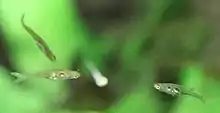Danionella translucida
Danionella translucida is an extremely small (1.1 cm long) species of cyprinid fish endemic to Myanmar. When described, it was considered to be one of the smallest fish. It was collected from the roots of floating aquatic plants in a slow-flowing, shallow stream (maximum depth 1 m) in the Pegu Division of Myanmar. It was found alongside Danio, Microrasbora, Erethistes, and Oryzias species. Observed in life, D. translucida is almost perfectly transparent except for its eyes. It has a distinctive pattern of melanophores. There are no melanophores on the dorsal surface except on the head over the posterior part of the brain. On the posterior half of the body, there a few melanophores following the horizontal midline. The sides and underside of the abdomen have melanophores. A double row of melanophores is present on the underside of the fish from the isthmus of the gills to the pelvic fins. Eggs in D. translucida has been found to range in size from about 0.3–0.6 mm (0.012–0.024 in) in diameter, with ripe eggs being at least 0.5 mm (0.020 in) in diameter. Females carried anywhere from 3 to 8 or 10 eggs. Compared to the body of the fish, these eggs are relatively large.[2]
| Danionella translucida | |
|---|---|
 | |
| Danionella translucida at Bolton Aquarium | |
| Scientific classification | |
| Kingdom: | Animalia |
| Phylum: | Chordata |
| Class: | Actinopterygii |
| Order: | Cypriniformes |
| Family: | Cyprinidae |
| Subfamily: | Danioninae |
| Genus: | Danionella |
| Species: | D. translucida |
| Binomial name | |
| Danionella translucida T. R. Roberts, 1986 | |
References
- Froese, Rainer and Pauly, Daniel, eds. (2011). "Danionella translucida" in FishBase. August 2011 version.
- Britz, R. (2010). "Danionella translucida". IUCN Red List of Threatened Species. 2010: e.T180101A7642448. doi:10.2305/IUCN.UK.2010-4.RLTS.T180101A7642448.en. Retrieved 14 January 2018.
- Roberts, Tyson R. (1986). "Danionella translucida, a new genus and species of cyprinid fish from Burma, one of the smallest living vertebrates". Environmental Biology of Fishes. 16 (4): 231–241. doi:10.1007/BF00842977.
